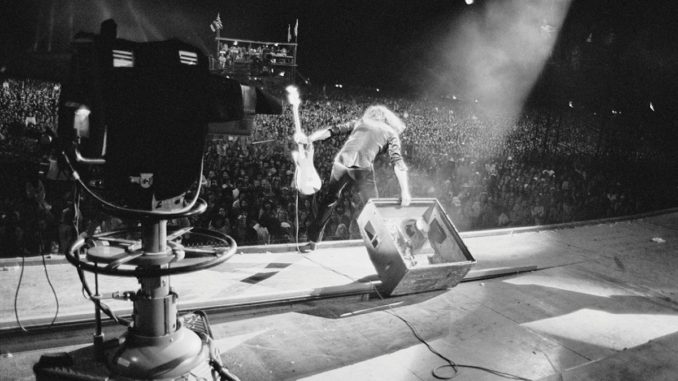
California Jam (often simply called Cal Jam) was more than a rock music festival. It was a gigantic event co-headlined by Deep Purple and ELP, held at the Ontario Motor Speedway in Ontario, California on 6th April 1974. It attracted somewhere between 300,000 to 400,000 fans.
The festival set the record for the loudest amplification system ever installed. It also had the highest paid attendance and highest gross in history. The highest show attendance was still the Woodstock festival outside of New York in 1969, but only a few thousand had actually purchased tickets before it was made into a free festival.
Deep Purple had just regenerated into their third line-up, popularly referred to as “Mark III”, which included new members David Coverdale (vocals) and Glenn Hughes (bass/vocals) alongside stalwarts Ritchie Blackmore (guitar), Jon Lord (keyboards) and Ian Paice (drums). They had just completed a month of shows in the US as they arrived for what looked like a big finale in front of the biggest audience anyone had ever played to.
Deep Purple arrived for the concert in their own chartered jet, the Starship, with their name painted on the plane’s sides. It was the first time a major band arrived specifically for a music festival in their own plane.
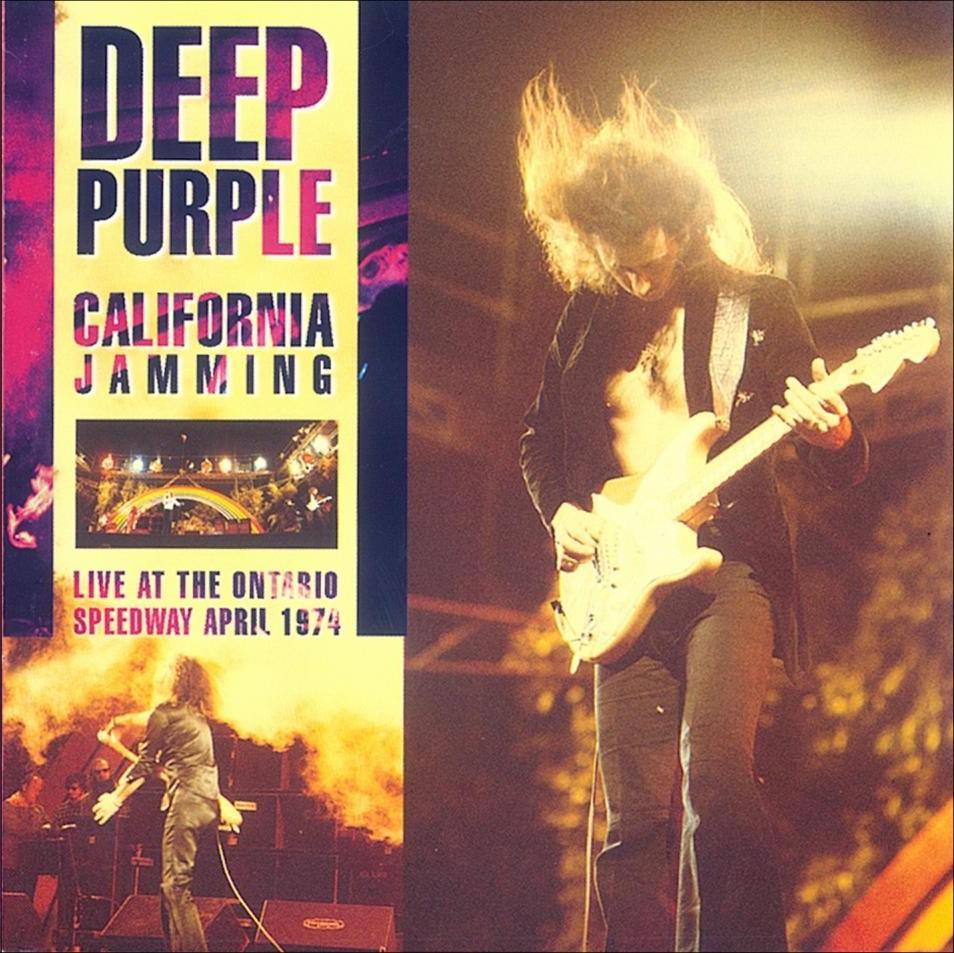
As headliner, Deep Purple had originally been given the choice of when to go on stage. They chose to go on during sunset, thus pushing Emerson, Lake & Palmer to the last performance. They reasonably had chosen the best time to go on for their stage lights to be the most effective.
The festival was however so well-organised it ran well ahead of time. A big part of the reason was another first: the setting of the stage sets for each band ran on rails. This allowed the crew to set up the next band while the previous band was still playing, and just push the new stage in when ready.
This rapid changeover eliminated a lot of the usual delays, and by 6.30 pm there were two bands left to go. The audience settled themselves for a short wait. Backstage, however, things began to turn sour.
Deep Purple had arrived on site with an hour in hand to prepare themselves, when they were told their gear was all set up and asked if they would go straight on. The band declined. The organisers started insisting. Tempers quickly started to fray as the band stalled, refusing to lose their sunset moment.
Ritchie Blackmore told a reporter afterwards: “We were the headliners of the show and we were supposed to go on the stage at dusk – 7.30 pm. We arrived early, to tune up and sort everything out, but when we got there the promoter came up to us and said we had got to go on. We outright refused. It was 6.30 and we weren’t about to do anything of the sort.”
The promoter couldn’t see it and had other ideas, as he got angry and began to put it quite forcefully to Blackmore in particular, who was the most insistent one. The guitarist later said: “He started threatening us. I just ignored him. The guy kept standing there and said we’d be off the show if I wasn’t on stage by the time he counted to 30. I sat there, tuned my guitar and listened to him count out loud. He hadn’t reached 15 when I had him thrown out. Forget the money we stood to lose, it was a matter of principle.”
The promoter then tried convincing the rest of the band to do something, and Jon Lord – ever the peacemaker – was asked to speak to Blackmore. This just aggravated the guitar player further. “He came to me and asked if I would go on for the rest of the band. I told him absolutely not, and was ready to quit the band then and there,” was Blackmore’s dry summary.
The weather on the day of the concert was unusually hot for that time of year, which may be one reason the audience stayed mellow while waiting. At one point in the afternoon, thousands of plastic gallon jugs were handed out to the audience, who were able to fill them up at the many drinking fountains that had been set up on the grounds.
During the prolonged delay waiting for Deep Purple to hit the stage, restless concert goers began tossing the jugs in the air. More and more of the audience joined in until the air above the crowd was filled with thousands of water jugs flying around, spraying water over everyone.
Blackmore stayed in the dressing room until sundown when another ABC manager ventured in and Blackmore agreed to go on. At that point, it was after all time.
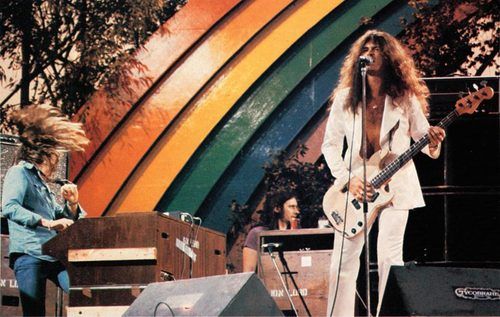
Fired up by all that had happened, the band burst onto the stage with high energy, channelling their aggression into the show. Led by Blackmore, the band ripped through the songs with a passion, making it a truly electrifying performance.
As the show went on, Blackmore’s anger started focusing itself on the ABC cameras – specifically those on stage. ABC used traditional TV studio sized cameras to capture the show, and would go to any lengths to get the shots they wanted. The operator on stage right was especially pushing his luck, taking his lumbering beast right across Blackmore’s side of the stage at times. It did not help that he often blocked the audiences view. Blackmore told him to get out of there several times. The camera would back off a little, but kept coming back. We can see things brewing as the show goes on, with Blackmore throwing several glaring stares at the camera. He started telling the camera operator to get the f*ck off the stage. He didn’t.
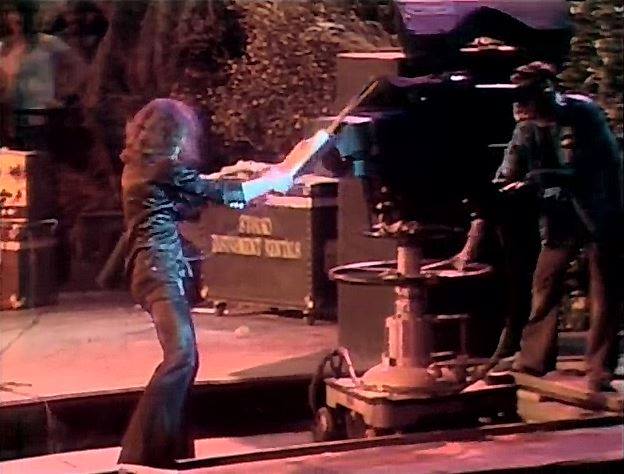
As they got into the end number, a rousing half-hour version of Space Truckin’, Blackmore went off the rails during his extended solo. With the band providing a pounding backdrop of energetic urgency, Blackmore sent his Stratocaster guitar soaring towards the heavens, bounced it off the stage floor, and began to destroy it. Amps and speaker cabinets were thrown out into the audience. A new guitar was brought out after the first one also got lost in action. In the middle of all this, the camera operator moved in closer again to capture the carnage. Because of this he scored the prize footage of the day, even though he barely managed to register what hit him. Out of the blue, a menacing-looking Blackmore came for the camera, guitar in hand. The Stratocaster slammed into the camera lens. Blackmore kept pummelling the camera again and again, rendering both guitar and camera inoperable. He ended it all by inserting the broken neck of the guitar into the lens.
“Actually I hadn’t planned to go for the camera,” Blackmore commented after the show. “I was out to kill the guy who gave me the countdown. I thought he’d be onstage. If he had been, you would’ve seen more than a smashed camera! I don’t like violence but I was raving that night. Anyway, I couldn’t spot him so I had a go at the camera.”
ELP fans have always had a grudge towards Deep Purple because of this. Thanks to Blackmore’s antics, there was now one less stage camera on hand to capture ELP’s performance!
That was not to be the end, though. Shortly after the camera assault, a 450 watt Marshall stack exploded. Blackmore was still angry, and asked the roadies to dowse the cabinets with gasoline. He wanted to light them on fire. Depending on who you ask it may or may not have been prepped with some explosives as well. Whatever was done, it ended up being overdone. The explosion made such a big shock wave that Blackmore was almost blown over the edge of the stage in the process. Bits of burning debris scattered all over, setting fire to most of the surrounding stage set.
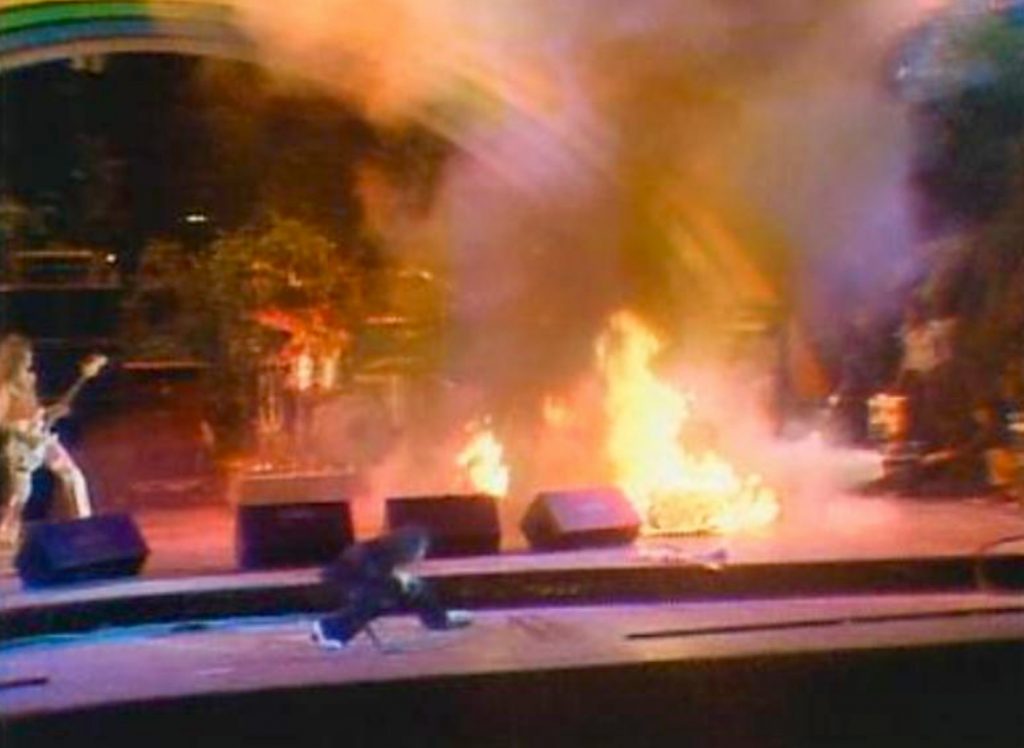
Ian Paice later said, “I was lifted off my drum stool by the blast. Fortunately the stool and all my drums were fastened, so I was quickly able to adjust and continue playing.” Jon Lord, who was situated on the other side of the stage, also said that the blast had driven him a foot or two back, away from his keyboards.
The stage was covered with actual flames and smoke – you see people rushing on to put out the fire! Meanwhile, the band keeps firing away amid the flames and smoke, Glenn Hughes actually stepping into the middle of the carnage for good effect! This certainly brought the Purple set to a suitably impressive visual climax. Blackmore always knew how to make an impression.
In the control booth, the Deep Purple management was already having an argument with ABC when the explosion happened. The ABC representatives were furious about the band’s delay in going on stage, screaming “You’re never going to work with us again!” The manager noticed the explosion, positioning himself in front of the TV monitor so that the ABC people wouldn’t see what happened. While a delay was achieved there was no hiding what had happened for very long, and people closer to the stage had already called in the fire marshals and police in any case.
After the show, the group made a quick exit by helicopter to avoid a possibly ugly confrontation with furious fire marshals and ABC-TV executives (and potential arrest for the pyrotechnics). “The police was coming to arrest us,” Blackmore later said. “We had our own helicopter so quickly got inside and got out of there. We could see the blue lights approaching the site.”
ABC were very upset by the whole turn of events, despite a conciliatory letter from Purple’s management offering to pay for “reasonable cost of whatever repairs are necessary” after “the Deep Purple lead guitarist clearly damaged one of your company’s television cameras in the enthusiasm of the moment”! The damage to the camera was estimated to be $10,000, later settled by the managers. Not that this prevented Ritchie from having later run-ins with on-stage camera personnel.
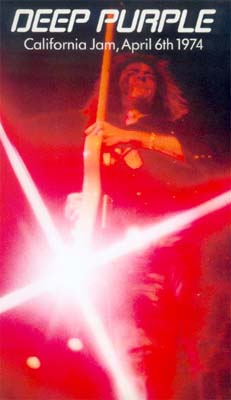
Deep Purple’s California Jam performance, along with some of the performances by other bands, was broadcast on TV and radio nationwide in the US. On that day, though, Deep Purple clearly stole the show and it was instantly sought after by collectors.
Perhaps for this reason, Deep Purple’s California Jam performance was the first full-length music concert film to be released and sold on video tape in the early 1980s. It was also the first VHS music video release this writer ever bought, and it just may be the show I have seen the highest number of times. The image to the left is how the cover looked back then.
It has since been released many times with different covers on LP, CD, DVD and Blu-ray, for the simple reason that it is still highly regarded and without question one of the band’s classic performances.

Facebook Comments